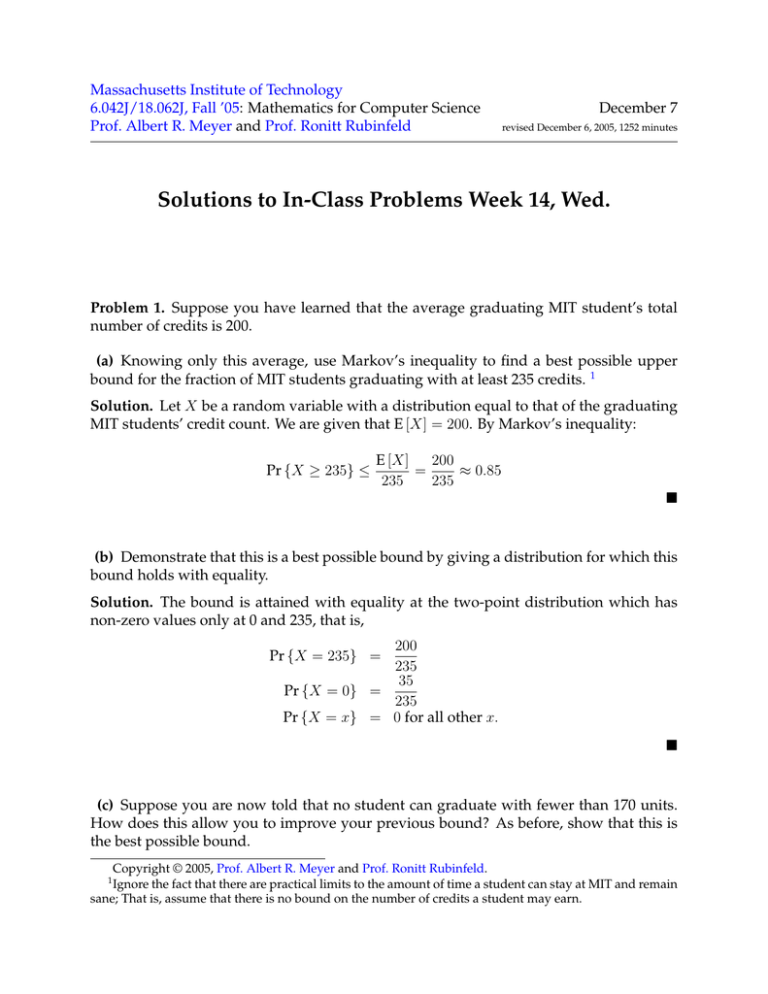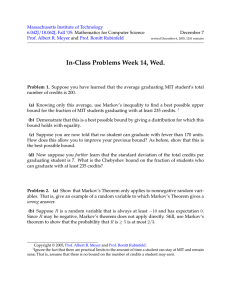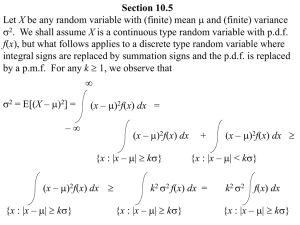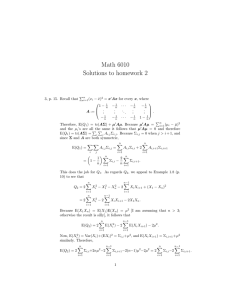: Mathematics for Computer Science December 7 and Massachusetts Institute of Technology
advertisement

Massachusetts Institute of Technology
6.042J/18.062J, Fall ’05: Mathematics for Computer Science
Prof. Albert R. Meyer and Prof. Ronitt Rubinfeld
December 7
revised December 6, 2005, 1252 minutes
Solutions to In­Class Problems Week 14, Wed.
Problem 1. Suppose you have learned that the average graduating MIT student’s total
number of credits is 200.
(a) Knowing only this average, use Markov’s inequality to find a best possible upper
bound for the fraction of MIT students graduating with at least 235 credits. 1
Solution. Let X be a random variable with a distribution equal to that of the graduating
MIT students’ credit count. We are given that E [X] = 200. By Markov’s inequality:
Pr {X ≥ 235} ≤
200
E [X]
≈ 0.85
=
235
235
�
(b) Demonstrate that this is a best possible bound by giving a distribution for which this
bound holds with equality.
Solution. The bound is attained with equality at the two­point distribution which has
non­zero values only at 0 and 235, that is,
200
235
35
Pr {X = 0} =
235
Pr {X = x} = 0 for all other x.
Pr {X = 235} =
�
(c) Suppose you are now told that no student can graduate with fewer than 170 units.
How does this allow you to improve your previous bound? As before, show that this is
the best possible bound.
Copyright © 2005, Prof. Albert R. Meyer and Prof. Ronitt Rubinfeld.
Ignore the fact that there are practical limits to the amount of time a student can stay at MIT and remain
sane; That is, assume that there is no bound on the number of credits a student may earn.
1
Solutions to In­Class Problems Week 14, Wed.
2
Solution. We can now apply Markov’s inequality to the nonnegative variable Y = X −
170, with expectation E [Y ] = E [X − 170] = E [X] − 170 = 30. So,
Pr {X ≥ 235} = Pr {X − 170 ≥ 235 − 170} = Pr {Y ≥ 65}
Therefore:
Pr {X ≥ 235} = Pr {Y ≥ 65}
E [Y ]
≤
65
30
≤
≈ 0.46
65
As above, we achieve an optimum (equality in the bound) when our distribution consists
of two spikes: one at (x − 170) = c − 170, that is, x = 235, and one at (x − 170) = 0, that is,
x = 170.
Pr {X = 235} = (200 − 170)/(235 − 170) = 30/65
Pr {X = 170} = 35/65
Pr {X = x} = 0 for all other x
�
(d) Now suppose you further learn that the standard deviation of the total credits per
graduating student is 7. What is the Chebyshev bound on the fraction of students who
can graduate with at least 235 credits?
Solution. The variance of X is the square of the standard deviation, or 49. The variance of
Y is the same as that of X, by the linearity of variance. That is, Var [Y ] = Var [X − 170] =
Var [X] − Var [170] = 49 − 0. (The variance of a constant is 0).
Pr {X ≥ 235} =
=
=
≤
Pr {Y ≥ 65}
Pr {Y − E [Y ] ≥ 65 − E [Y ]}
Pr {Y − 30 ≥ 35}
Pr {|Y − 30| ≥ 35}
Var [Y ]
≤
352
49
1
=
≤
1225
25
This is a much better bound than before!
�
Solutions to In­Class Problems Week 14, Wed.
3
Problem 2. (a) Show that Markov’s Theorem only applies to nonnegative random vari­
ables. That is, give an example of a random variable to which Markov’s Theorem gives a
wrong answer.
Solution. Here is one possible answer: Let R be ­10 with probability 1/2 and 10 with
probability 1/2. Then we have:
E [R] = −10 ·
1
1
+ 10 · = 0
2
2
Suppose that we now tried to compute Pr {R ≥ 5} using Markov’s Theorem:
Pr {R ≥ 5} ≤
E [R]
0
= = 0.
5
5
This is the wrong answer! Obviously, R is at least 5 with probability 1/2.
�
(b) Suppose R is a random variable that is always at least −10 and has expectation 0.
Since R may be negative, Markov’s theorem does not apply directly. Still, use Markov’s
theorem to show that the probability that R is ≥ 5 is at most 2/3.
Solution. Let T ::= R + 10. Now T is a nonnegative random variable with expectation
E [R + 10] = E [R] + 10 = 10, so Markov’s Theorem applies and tells us that Pr {T ≥ 15} ≤
10/15 = 2/3. But T ≥ 15 iff R ≥ 5, so Pr {R ≥ 5} ≤ 2/3.
�
Problem 3. There are n people at a circular table in a Chinese restaurant. On the table,
there are n different appetizers arranged on a big Lazy Susan. Each person starts munch­
ing on the appetizer directly in front of him or her. Then someone spins the Lazy Susan
so that everyone is faced with a random appetizer. In class, we saw that the expected
number of people that end up with the appetizer that they had originally is 1.
Let Xi be the indicator variable for the ith person getting their own appetizer
�nback. Let
Sn be the total number of people who get their own appetizer back, so Sn = i=1 Xi .
(a) What is E [Xi2 ]?
Solution. Xi = 1 with probability 1/n and 0 otherwise. Thus Xi2 = 1 with probability 1/n
and 0 otherwise. So E [Xi2 ] = 1/n.
�
(b) For i �= j, what is E [Xi Xj ]?
Solutions to In­Class Problems Week 14, Wed.
4
Solution. The probability that Xi and Xj are both 1 is 1/n. Thus Xi Xj = 1 with probabil­
ity 1/n, and is zero otherwise. So E [Xi Xj ] = 1/n.
�
(c) What is E [Sn2 ]?
Solution.
�
� �
E [Xi Xj ]
E Sn2 =
i,j
1
= n2 ·
n
= n.
Alternatively, we observe directly that
�
�
1
Pr Sn2 = n2 Pr {Sn = n} =
n
and
so
�
�
n−1
Pr Sn2 = 0 Pr {Sn = 0} =
,
n
� �
1
n−1
E Sn2 = n2 + 0 ·
= n.
n
n
�
(d) What is Var [Sn ]?
Solution.
� �
Var [Sn ] = E Sn2 − E2 [Sn ]
= n − 12
= n − 1.
�
(e) Discuss the accuracy of the Chebyshev Bound on the probability that Sn is distance
x from its expectation as x ranges over integers between 1 and n.
Solution.
Var [Sn ] /x2 is trivial (> 1) unless x2 > varianceSn , that is, unless
�
�√ The bound
n − 1 + 1 . In the �√
x≥
case that x equals
this minimum value, it still gives yields a near
�
trivial bound of (n − 1)/ n − 1 + 1 ≈ 1, whereas actually,
Pr {|Sn − 1| ≥ x} =
1
n
Solutions to In­Class Problems Week 14, Wed.
5
for all x ≤ n − 1, and
Pr {|Sn − 1| ≥ x} = 0
for x > n − 1. At x = n − 1, the Chebyshev Bound is (n − 1)/(n − 1)2 = 1/(n − 1) which
is still a bit larger than the actual value of 1/n. Finally, at x = n, the Chebyshev Bound is
�
(n − 1)/n2 = 1/n − 1/n2 whereas the actual probability is zero.
Problem 4. For any random variable, R, with E [R] = µ and Var [R] = v, the Chebyshev
Bound says that for any real number x > 0,
v
Pr {|R − µ| ≥ x} ≤ 2 .
x
Show that for any real number, µ, and real numbers v, x > 0, there is an R for which the
Chebyshev Bound is tight, that is,
v
(1)
Pr {|R| ≥ x} = 2 .
x
Hint: Assume µ = 0 and let R be three valued with values 0, −x, and x.
Solution. From the hint, we aim to find an R with E [R] = 0 and Var [R] = v that satisfies
equation (1).
Using the further hint that R takes only values 0, −x, x, we have
0 = E [R] = x Pr {R = x} − x Pr {R = −x} = x (Pr {R = x} − Pr {R = −x})
so
Pr {R = x} = Pr {R = −x} ,
(2)
since x > 0. Also,
� �
v = Var [R] = E R2 = x2 Pr {R = −x} + x2 Pr {R = x} = 2x2 Pr {R = x} ,
so
Pr {R = x} =
v
.
2x2
This implies
Pr {R = 0} = 1 − Pr {R = −x} − Pr {R = x} = 1 −
v
,
x2
which completely determines the distribution of R. Moreover,
Pr {|R| ≥ x} = Pr {R = −x} + Pr {R = x} =
v
x2
which confirms (1).
Finally, given µ, x, and v, if we let R� ::= R + µ, then R� will be the desired random variable
for which the Chebyshev Bound is tight.
�
Solutions to In­Class Problems Week 14, Wed.
6
Problem 5. The covariance, Cov [X, Y ], of two random variables, X and Y , is defined to
be E [XY ] − E [X] E [Y ]. Note that if two random variables are independent, then their
covariance is zero.
(a) Give an example to show that having Cov [X, Y ] = 0 does not necessarily mean that
X and Y are independent.
Solution. Let (X, Y ) have joint probability given by the table below:
X
−1
0
1
Y P
1 1/3
0 1/3
1 1/3
Note that X and Y are not independent:
Pr {X = 1 & Y = 1} = 1/3 �= 2/9 = Pr {X = 1} Pr {Y = 1} .
But since XY = X and E [X] = 0, we have
E [X] E [Y ] = 0 · E [Y ] = 0 = E [X] = E [XY ] .
Thus Cov [X, Y ] = 0.
�
(b) Let X1 , . . . , Xn be random variables. Prove that
Var [X1 + · · · + Xn ] =
n
�
Var [Xi ] + 2
i=1
�
Cov [Xi , Xj ] .
i<j
Solution.
�
�
Var [X1 + · · · + Xn ] = E (X1 + · · · + Xn )2 − E2 [X1 + · · · + Xn ]
�
� �
�
�
�
�
�
= E
Xi2 + (
2Xi Xj ) −
E [Xi ]2 +
2 E [Xi ] E [Xj ]
i
i<j
i
i<j
� � � �
�
�
=
E Xi2 +
2 E [Xi Xj ] −
E [Xi ]2 −
2 E [Xi ] E [Xj ]
i
i<j
i
i<j
� � �
�
=
E Xi2 − E [Xi ]2 +
2(E [Xi Xj ] − E [Xi ] E [Xj ])
i
=
�
i
i<j
Var [Xi ] + 2
�
Cov [Xi , Xj ] .
i<j
�









